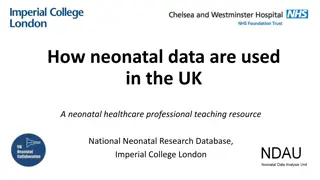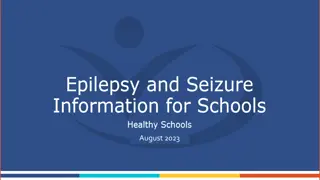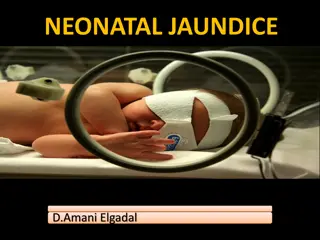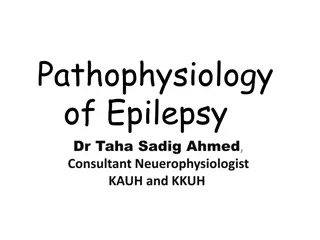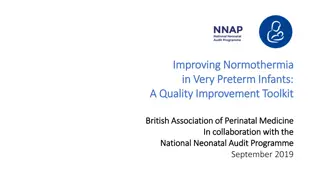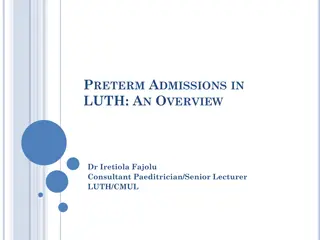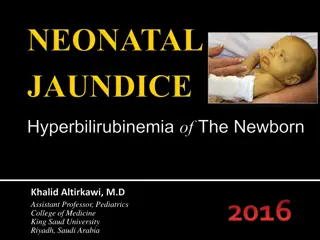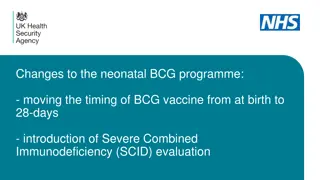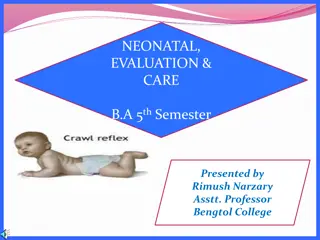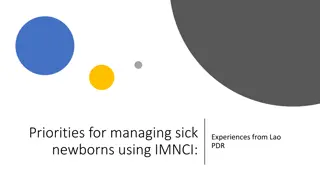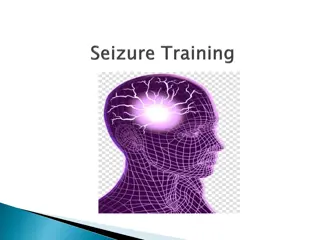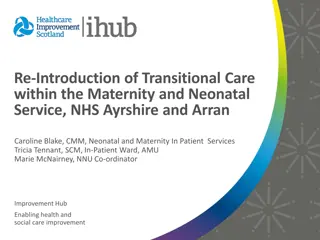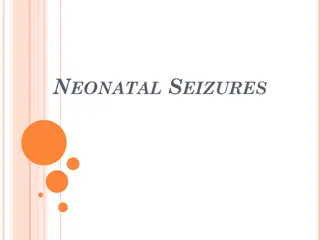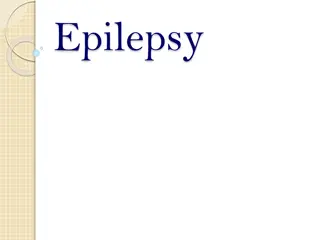Understanding Neonatal Seizures and Their Pathophysiology
Neonatal seizures are sudden changes in neurologic function of a newborn, involving motor, behavior, and autonomic functions. The pathophysiology includes delays in Na/K ATPase maturation, increased receptor density, and GABAergic transmission. Different types of seizures like subtle, clonic, tonic, myoclonic, and spasms can occur, each presenting unique symptoms. Various factors such as hypoxic-ischemic encephalopathy, drug withdrawal, and metabolic disorders can contribute to neonatal seizures.
Download Presentation

Please find below an Image/Link to download the presentation.
The content on the website is provided AS IS for your information and personal use only. It may not be sold, licensed, or shared on other websites without obtaining consent from the author. Download presentation by click this link. If you encounter any issues during the download, it is possible that the publisher has removed the file from their server.
E N D
Presentation Transcript
NEONATAL SEIZURE DR DEBANJANA BASAK
DEFINITION A seizure is a sudden alteration in neurologic function of a neonate thatis motor, behaviour and or autonomic function. This definition includes Epileptic Seizure: Phenomena associated with corresponding EEG activity;eg clonic seizure Non-epileptic Seizure: Clinical seizures without corresponding EEG correlate ; eg subtle and generalized tonic seizures EEG Seizures: Abnormal EEG activity with no clinical correlation Seizures are possibly the most important and common indicator of significant neurologic dysfunction in the neonatal period.
PATHOPHYSIOLOGY Delay in Na K ATPase maturation Increased level of NMDA and AMPA receptor density Delay in development of inhibitory GABAergic transmission GABA in the immature brain has an excitatory function as the chloride gradient is reversed relative to the mature brain, with higher concentrations of chloride being present intracellularly than extracellularly.
CONT.. NKCC1 is predominantly expressed in the neonatal period Leading to transport of Cl into the cell at rest, Then to cellular depolarization upon activation of GABAA receptors and opening of Cl channels with chloride efflux. With maturation, expression of NCCK1decreases and KCC2 increases. KCC2 transports Cl out of the cell
TYPES OF NEONATAL SEIZURES 5 main types of neonatal seizure Subtle Seizures Clonic Seizures Tonic Seizures Myoclonic Seizures Spasms
Cont Subtle Seizure Apnoea Oral-facial- lingual movement Chewing, tongue thursting, lip smaking Limb Ocular tonic horizontal deviation of eyes Autonomic phenomena Bradycardia, Tacycardia movement Cycling, pedaling, boxing jabs
ETIOLOGY Causes of Neonatal Seizures According to Common Age of Presentation AGES 1-4 DAYS Hypoxic ischemic encephalopathy Drug withdrawal, maternal drug use of narcotic or barbiturates Drug toxicity: lidocaine, penicillin Intraventricular hemorrhage Acute metabolic disorders
CONT AGES 4-14 DAYs Infection ,Metabolic cause AGES 2-8 WK Infection Herpes simplex or enteroviral encephalitis Bacterial meningitis Head injury Subdural hematoma
CONT. Inherited disorders of metabolism Aminoacidurias Urea cycle defects Organic acidurias Neonatal adrenoleukodystrophy Malformations of cortical development Lissencephaly
Neonatal Seizure Syndromes Benign idiopathic neonatal seizures (fifth day fits):which are usually apneic and focal motor seizures that start around the fifth day of life. Interictal EEG shows a distinctive pattern called theta pointu alternant (runs of sharp 4-7 Hz activity), and ictal EEG shows multifocal electrographic seizures. Patients have a good response to medications and a good prognosis. Benign familial neonatal seizures:have onset at 2-4 days of age and usually remit at 2-15 wk of age. The seizures consist of ocular deviation, tonic posturing, clonic jerks, and, at times, motor automatisms. Interictal EEG is usually normal. These are caused by mutations in the KCNQ2 and KCNQ3 genes. Approximately 16% of patients developlater epilepsy.
Early myoclonic encephalopathy :starts during the 1st 2 mo of life with severe myoclonic seizures and burst suppression pattern on EEG. It is usually caused by inborn errors of metabolism such as non-ketotic hyperglycinemia. Early infantile epileptic encephalopathy (Ohtahara syndrome):has similar age of onset and EEG but manifests tonic seizures and is usually caused by brain malformations or syntaxin binding protein 1 mutations.
DIAGNOSIS Seizure history Antenatal history Perinatal History Family History Feeding History
Examination Vital signs: Heart rate, respiration ,blood pressure, CRT General examination: Gestation, birth weight, and weight for age, any obvious malformations or dysmorphic features. Jitteriness may be an associated finding in seizure due to hypoglycemia or hypocalcemia. CNS examination: Presence of bulging anterior fontanel may be suggestive of meningitis or intracranial haemorrhage. A detailed neurological examination should include assessment of consciousness, tone and fundus examination Systemic examination: Presence of hepatosplenomegaly or an abnormal urine odor might suggest of IEM. The skin should be examined for any neurocutaneous marker.
INVESTIGATIONS Mandatory Investigations Blood sugar Haematocrit Bilirubin if jaundice is present clinically Serum electrolyte (Na Ca Ma) ABG, AG CSF examination
Cont Cranial USG: Excellent tool for detection of intraventricular and intra parenchymal haemorrhage but will not be able to detect SAH and subdural haemorrhage. EEG: Conventional continuous EEG has role in both diagnosis and prognosis of seizure. Ictal EEG may be helpful for diagnosis. Inter ictal EEG is helpful for prognostication of seizure. A background abnormality in both term and preterm neonates indicate a high risk neurological sequelae. These changes include burst suppression, low voltage invariant pattern,electrocerebral inactivity. Amplitude integrated EEG is helpful in evaluating the background as well in identification of seizure activity in NS CT scan MRI Screening for congenital infections TORCH screening and VDRL
EEG.. Burst suppression pattern Sharp and spike waves
Cont Blood and urine ketones Urine reducing substances Blood ammonia and anion Gap Urine and plasma amino acidogram Serum and CSF pyruvate lactate ratio Metabolic screening
Cont Levetiracetam: Levetiracetam is increasingly being used in neonates as first line or second line drug based on its safety profile in older children. It also has the advantage of having less side effects and drug interactions. Seizure control of almost 60% has been reported with a loading dose of 50mg/kg/day. Pyridoxine
Drugs used for refractory seizures Lidocaine: Usually administered as a bolus dose of 4mg/kg Iv followed by an infusion rate of 2mg/kg/hr. It is tapered over several days. Paraldehyde Na valproate: Per rectal or IV route may be used in acute condition. The dose is 20-25mg/kg/day followed by 5-10mg/kg every 12hour. Vigabatrin: Used in infantile spasms with a dose 50mg/kg/day. Topiramate: It shows promise in neonatal seizure because of its potential neuroprotective effect against injury caused by seizure. It has been used in refractory infantile spasms.


